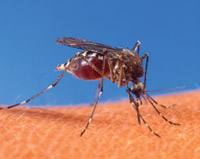
Anything's worth against mosquitoes
- The bite of mosquitoes, in addition to being uncomfortable, transmits diseases such as malaria, malaria and dengue. But not all mosquitoes bite; it’s the females who have to lay eggs that go in search of the proteins in the blood of mammals.
Joxerra Aizpurua Sarasola
2008ko urtarrilaren 28a

Aedes aegypti espezieko eltxoa
A group of researchers from the University of Arizona have observed the release of nitrogen after the bite of the females, and during the metabolism of the absorbed blood, a behavior found in the mosquito species Aedes aegypti.
The discovery opens a new path in the fight against mosquitoes. By preventing the release of nitrogen to blood-necked females, they would not be able to metabolize the blood and die.
They want to implement this principle in insecticides by developing a molecule that prevents the release of nitrogen. Mixing this molecule with classic insecticides and spreading it to mosquito breeding sites would open the way to killing them. In addition, pills can be given to the inhabitants of places where there are many mosquitoes. In this way, the mosquitoes would become infected during the bite. It is noted that the system according to the invention does not prevent the bite from being received, but it can be assured that it will be the last bite of this mosquito.
In Madagascar they find a type of giant palm tree that only blooms once in a lifetime and then kills itself. This species, which may be five meters in diameter and twenty meters high, has been called Tahina spectabilis by researchers. Flowering begins when the tree is over 50 years old. At the top of the palm there is only one flower growing initially; after a few weeks there are hundreds of small flowers in the upper branches. Each of them can be pollinated and consequently turned into fruit, after which the palm dies immediately.
Madagascar, because it is an island, has many species that are not found in other parts of the world. Of the 10,000 native plant species, 90% are not found anywhere else. Among other things, there are 170 species of palm trees on the island.
The discovery opens a new path in the fight against mosquitoes. By preventing the release of nitrogen to blood-necked females, they would not be able to metabolize the blood and die.
They want to implement this principle in insecticides by developing a molecule that prevents the release of nitrogen. Mixing this molecule with classic insecticides and spreading it to mosquito breeding sites would open the way to killing them. In addition, pills can be given to the inhabitants of places where there are many mosquitoes. In this way, the mosquitoes would become infected during the bite. It is noted that the system according to the invention does not prevent the bite from being received, but it can be assured that it will be the last bite of this mosquito.
A palm tree that kills itself
In Madagascar they find a type of giant palm tree that only blooms once in a lifetime and then kills itself. This species, which may be five meters in diameter and twenty meters high, has been called Tahina spectabilis by researchers. Flowering begins when the tree is over 50 years old. At the top of the palm there is only one flower growing initially; after a few weeks there are hundreds of small flowers in the upper branches. Each of them can be pollinated and consequently turned into fruit, after which the palm dies immediately.
Madagascar, because it is an island, has many species that are not found in other parts of the world. Of the 10,000 native plant species, 90% are not found anywhere else. Among other things, there are 170 species of palm trees on the island.